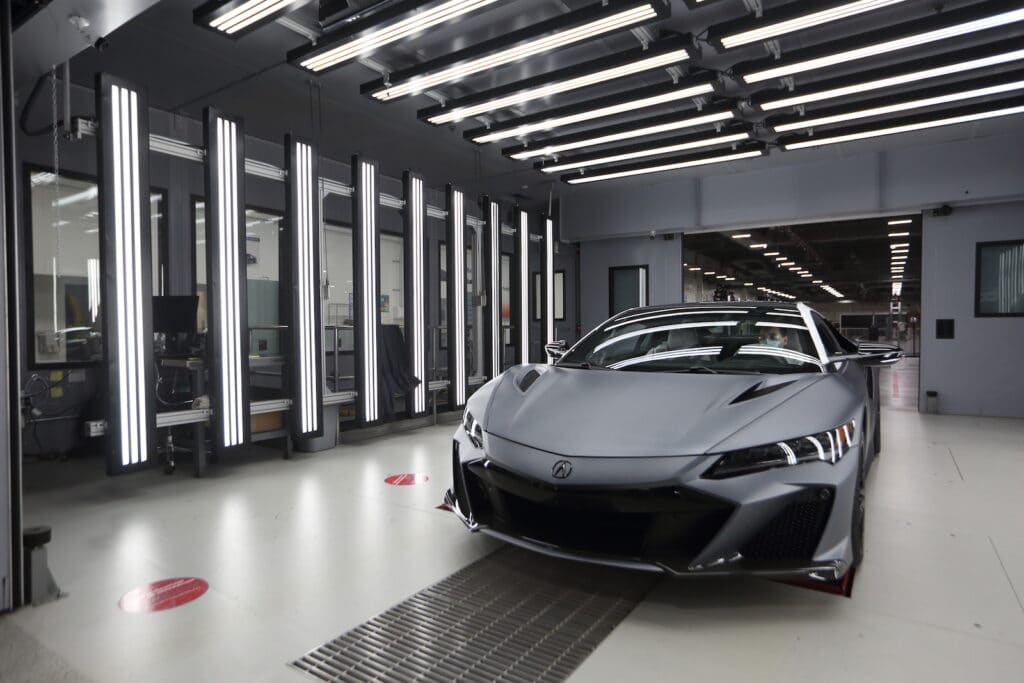Acura NSX Returning in All-Electric Form, Confirms Brand Boss Ikeda
Even as Acura bids farewell to the second-generation NSX at the end of the 2022 model year, the Japanese luxury brand is giving thought to bringing back the supercar — and, as would seem appropriate, one should expect it will be all-electric, brand chief Jon Ikeda told TheDetroitBureau.com.

The two NSX models Acura has built to date were designed not only to serve as brand flagships but to explore the use of new technologies, such as the benefits of a lightweight aluminum body and the performance and handling of a three-motor hybrid powertrain. If and when the NSX would be revived, Ikeda said, it would need to explore the potential performance capabilities of going all-electric. And that means more than just neck-snapping 0 to 60 acceleration.
“As long as we’re a fun-to-drive company there will always be a place for an NSX,” said Ikeda, during an interview in New York City. “The NSX is not like a (Porsche) 911, where you build a continuing series. It’s an innovation platform” that is revived only when there is an opportunity “to talk about our future.” And that means that when the NSX is next revived “it’s going to be electric,” Ikeda added.
First up: the Acura ZDX
Like the more mainstream Honda brand, electric vehicles will come to dominate Acura’s line-up over the course of this decade. Ikeda was in the Big Apple for a second media preview of the Acura Precision Concept, a prototype he and other officials noted, shows the design direction future battery-electric vehicles will take. The first of those BEVs, the Acura ZDX, will make its debut in 2024.

It will be offered in several different versions, including a sporty Type S, in keeping with the approach Acura today takes with other, gas-powered product lines, including the recently reborn Integra.
That’s in keeping with the broader industry trend. Where electrified vehicles — starting with hybrids — initially emphasized energy efficiency, automakers have discovered they can broaden the appeal by boosting performance.
Tire-spinning torque
The good news is that electric motors deliver maximum levels of torque the moment they start spinning. That can translate into incredible off-the-line performance. The Tesla Model S Plaid and Lucid Air Dream can hit 60 in barely 2 seconds and Croatia’s Rimac has suggested an upcoming BEV will cut that to a mere 1 second.
But while plenty of new BEVs can deliver neck-snapping launches, that doesn’t necessarily put them into the true supercar category, said Stephanie Brinley, principal analyst with IHS Markit.
“That’s only part of what performance is all about. It’s also about cornering, steering and chassis dynamics and,” she said, “that’s where many of the new electric vehicles fall short.”
Indeed, some can only manage a few quick launches — and then only when fully charged.
Performance+handling+endurance
While Ikeda was vague about details, he said the next NSX will have to deliver true supercar performance, meaning the ability to handle even the most challenging tracks, lap after lap after lap.

That was the approach Acura took with the second-generation NSX which returned for the 2016 model year. Its combination of a turbo-6 gas engine and three electric motors offered a quick 0-60 launch of around 2.9 seconds, as well as the steering and handling — and the endurance — you’d expect of a true supercar.
“It won’t be just about straight lines,” said Ikeda of the next-gen Acura NSX.
Timing
Beyond that, he and other company officials aren’t offering specifics. But one source suggested NSX fans will be in for a wait.
The Acura ZDX coming in 2024 will be the result of a joint venture between General Motors and Honda — the mass market Japanese brand also producing a mainstream BEV dubbed Prologue. ZDX and Prologue both will be based off the same “Ultium” platform used for GM products like the Cadillac Lyriq and Chevrolet Blazer.
What’s clear is that the third-generation NSX will be based on an entirely new platform that Honda is developing, the e:Architecture. And that won’t be available until 2026. It’s quite possible, if not likely, that the next supercar will be used to highlight the capabilities of that system and be at least one of, if not the first Acura models to use that platform.
Auto Lovers Land
Comments
Post a Comment